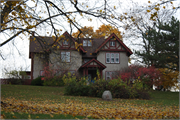Property Record
373 S KANE ST
Architecture and History Inventory
| Historic Name: | LOUIS H. & ELLA ROHR HOUSE |
|---|---|
| Other Name: | |
| Contributing: | Yes |
| Reference Number: | 221265 |
| Location (Address): | 373 S KANE ST |
|---|---|
| County: | Racine |
| City: | Burlington |
| Township/Village: | |
| Unincorporated Community: | |
| Town: | |
| Range: | |
| Direction: | |
| Section: | |
| Quarter Section: | |
| Quarter/Quarter Section: |
| Year Built: | 1908 |
|---|---|
| Additions: | |
| Survey Date: | 2011 |
| Historic Use: | house |
| Architectural Style: | English Revival Styles |
| Structural System: | Balloon Frame |
| Wall Material: | Stucco |
| Architect: | JOSEPH A RUETER & HENRY RUETER (BUILDER) |
| Other Buildings On Site: | Y |
| Demolished?: | No |
| Demolished Date: |
| National/State Register Listing Name: | Kane Street Historic District |
|---|---|
| National Register Listing Date: | 7/25/2014 |
| State Register Listing Date: | 11/22/2013 |
| National Register Multiple Property Name: |
| Additional Information: | Louis H. Rohr was born in Franklin, Wisconsin, in 1864, the son of Swiss and Prussian immigrants. In 1866, the Rohr family moved to Raymond, Wisconsin, where Louis was raised. He later taught school; studied law; apprenticed under his brother-in-law, Thomas M. Kearney; and was admitted to the Wisconsin bar in 1892. He then went into practice with Kearney in Burlington. The practice dissolved the following year when Kearney relocated to Racine; Rohr continued practicing in Burlington. Also in 1893, Rohr married Ella Davis of Milwaukee. Louis H. Rohr founded the Wisconsin Condensed Milk Company with Charles Bernard McCanna and Robert G. Fraser in 1898. Rohr served as the company’s secretary, treasurer, and one of its directors. Its milk condensing plant and canning factory, operating out of the non-extant McCanna & Fraser Company factory located on Bridge Street between Washington and Chestnut Streets, became the first and largest of its kind in Wisconsin. The company produced condensed milk primarily under the name Lion Brand but also canned milk for other companies and private brands. In 1901, the company built a tin can factory adjoining the condensory to manufacture its own packaging. A Burlington newspaper reported in 1903 that more milk was delivered daily to Burlington than any other city or village in the State, with the Wisconsin Condensed Milk Company receiving a majority of this shipment. Offices were moved to the Bank of Burlington Building upon its construction in 1909. Rohr was involved, as part of a group of local businessmen, with the purchase of all non-locally held stock in the Bank of Burlington in 1902. He became vice president of the Bank of Burlington in 1906. In this role, he was involved with the construction of the new building for the bank at 500 N. Pine Street in 1909. After completion of the new bank, Rohr re-located his law practice to its second floor along with offices of the Wisconsin Condensed Milk Company. In 1903, Rohr purchased the share of O. O. Storle in the Burlington Brass Works and served as one of that company’s directors and treasurer. A house was constructed for Rohr on Kane Street by Joseph A. and Henry Rueter in 1908. The Louis H. & Ella Rohr House is located at 373 S. Kane Street. For a period of time, Rohr served as city attorney and as a member of the school board. He was a member of the Burlington Free Masons. He passed away in Milwaukee in 1922. |
|---|---|
| Bibliographic References: | General Files. On file at the Burlington Historical Society, Burlington, Wisconsin. |
| Wisconsin Architecture and History Inventory, State Historic Preservation Office, Wisconsin Historical Society, Madison, Wisconsin |

